An IT outsourcing partner that is reliable and competent is a godsend for any modern digitally-driven enterprise, aspiring to enter the major league of business. But, because of the huge number of companies offering their services on the contemporary global market, making the right choice is often a problem. This article is meant to help you navigate in this vast and oftentimes confusing realm and cinch the best possible deal.
The Current Situation in the IT Outsourcing Services Market
In the early 21st century, IT outsourcing has quickly grown from a nascent trend into one of the pillars of our profoundly digitized civilization. While many businesses prefer to handle the development of software products by their in-house workforce, others opt for IT outsourcing which accounts for 13.6% of the global IT budget in 2020/2021. This is almost 1% more in comparison with 2019 and the number is only likely to grow. Why?
Two factors are responsible for the upward mobility of this industry. The first is the ever-increasing penetration of computer technologies into virtually all fields of the modern economy. The second is our post-COVID next normal that made the “remote everything” mode a dominant trend, vitally reliant on high-tech products. So, it is no wonder that last year the global IT outsourcing market topped $525 billion – an astounding figure that is likely to approach the breath-taking $682 within 5 years.
Among all software products, mobile apps are evidently the niche leaders. With the number of mobiles gizmos twice exceeding the global population, app development is sure to stay at the top of IT outsourcing services extended by vendors (there are over 7000 such companies in the USA only).
Given such bright prospects of IT outsourcing, it is natural that businesses employ it on a broadening scale. However, selecting the right vendor is a chief obstacle that confronts companies who have a software project to accomplish.
Why Choose An IT Outsourcing Service?
IT outsourcing has numerous assets as a business model.
1. Cost Efficiency
Hiring an in-house IT crew and paying them a monthly salary when what you need is an ERP for your company, an e-commerce website, or an educational app for your private school is a sheer waste of money. Moreover, by recruiting third-party developers for a one-time project you will save on the cost of equipment, working space, utilities, personnel training, and other expenditure items that are taken care of by the IT outsourcing vendor.
Cost-saving opportunities are pretty transparent and obvious here – an average German software developer’s rate is about €32 while you can easily find the same (or even higher) level of quality among Eastern European developers who charge €20-25. Many market’s biggest names were fast to grab such opportunities – Viber, WhatsApp, and many other booming projects did not come from America, but either from Ukraine, Israel, or Belarus.
2. Concentration on Core Business
Managers of small and medium businesses have their hands full with their particular activities and, as a rule, have little expertise in other fields. Notably, such highly specific ones as software development. So let professionals handle it and focus on trade, finance, healthcare, or what is it that you deal with.
3. Access to Global Talent Pool
Searching for talents, you aren’t limited by the boundaries of your city, region, or even country. You can collaborate with IT outsourcing vendors from all over the globe and land the best price/quality ratio.
4. Distribution of Tasks
If your IT project requires developers with various skills, each of them can do their part of the work being located in different parts of the world. Thus, your project will proceed faster and the time zone differences will enable virtually uninterrupted workflow. This is also a game-changer solution for all companies and projects looking for outsourced specialists not for the sake of hitting a proper headcount, but for filling the gaps in the expertise even when required specialists are hardly available locally.
5. Boosting Business in General
A company that delegates IT development to competent vendors frees human and financial resources for new projects and initiatives, which propels its overall progress, increases revenues, and gives it a considerable competitive edge at the end of the day.
You can make the best of these IT outsourcing perks only if you opt for the right pricing model.
Zooming in on an IT Outsourcing Vendor
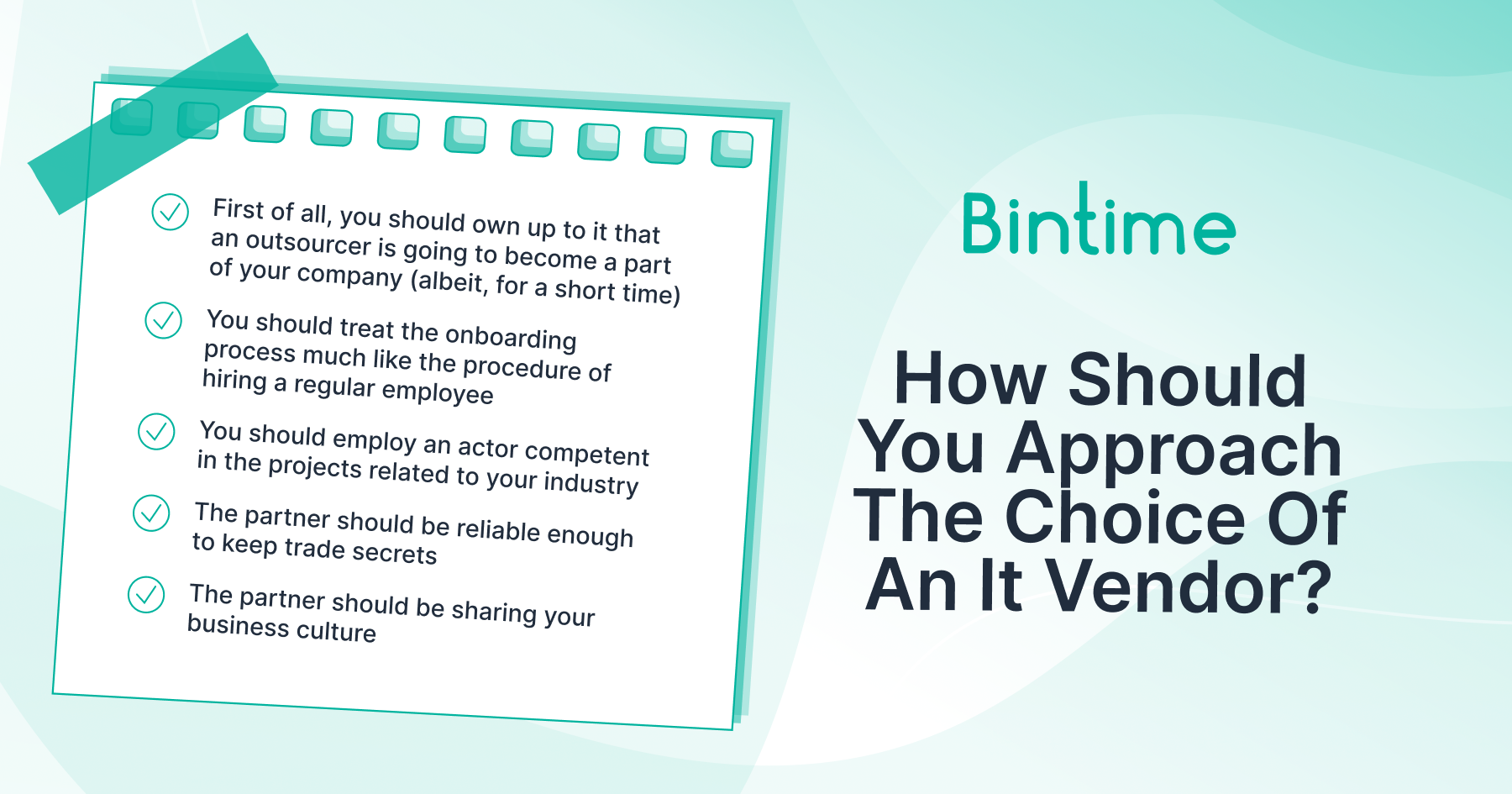
How should you approach the choice of an IT vendor?
First of all, you should own up to it that an outsourcer is going to become a part of your company (albeit, for a short time). That is why you should treat the onboarding process much like the procedure of hiring a regular employee.
As soon as you look at the selection of a vendor in this way, it becomes clear that you should employ an actor competent in the projects related to your industry. Moreover, such a partner should be reliable enough to keep trade secrets. Finally, sharing your business culture is also an important criterion that will narrow your choice significantly.
Your ultimate goal is to establish firm and transparent professional relationships with the real ace of their business. It is crucial to work with a contractor that not only possesses the proper “know-how” but is seeping competence, demonstrating experience and expertise upon every fitting turn. Your best bet is to collaborate with a vendor that is able to take full control and direct you across all underlying aspects.
Let’s imagine you have a candidate like that on your mind. But don’t you dive headlong into a large-scale project at once. To make doubly sure, start with a smaller one that will serve as a pilot testing of your future cooperation. If you feel comfortable with the vendor whose performance, pricing policy, and work ethic live up to your expectations, move on to a more serious endeavor. Once you hit the bull’s eye with the choice of the IT outsourcing vendor, all boons of this model will not be late in coming.
In order to pick a reliable vendor proficient in your business niche to partner up with, focus on the following defining characteristics:
- Reputation and experience. Above all else, you need a reputable vendor with a good amount of field experience and expertise in your niche. It’s best to build long-term collaboration than to try your luck with up-and-coming agencies.
- Portfolio and past successes. Take your time and research the products or services your potential outsourcing vendor successfully provided previously. Make sure those testimonials aren’t made up yourself.
- Extensive tech expertise. You are best off with an outsourcing provider that has a wide range of talents with various qualifications and tech skills in store. Make sure your potential vendor can help you fill up every role from designers and developers to analysts, advanced tech specialists (AI, AR/VR, Cloud, blockchain, etc.), and DevOps.
- Agile workflow. Vendors that run development workflows based on the Scrum-based agile methodology constantly improve processes by regularly collecting feedback and fixing all relevant issues accordingly. Keeping processes segmented and perfected gives your project scalability and makes testing and measurements easier.
- User-focused philosophy. Best products are created when you keep it individual and try on the end user’s shoes to achieve the highest target audience satisfaction rates. That’s why a good outsourcing vendor should ask a lot of questions, communicate, and gradually integrate with your brand culture.
Pricing Models Working with IT Outsourcing Vendor
There are several payment patterns existing in the realm of IT outsourcing services that are used depending on the nature of the project to be tackled and services to be rendered to the customer.
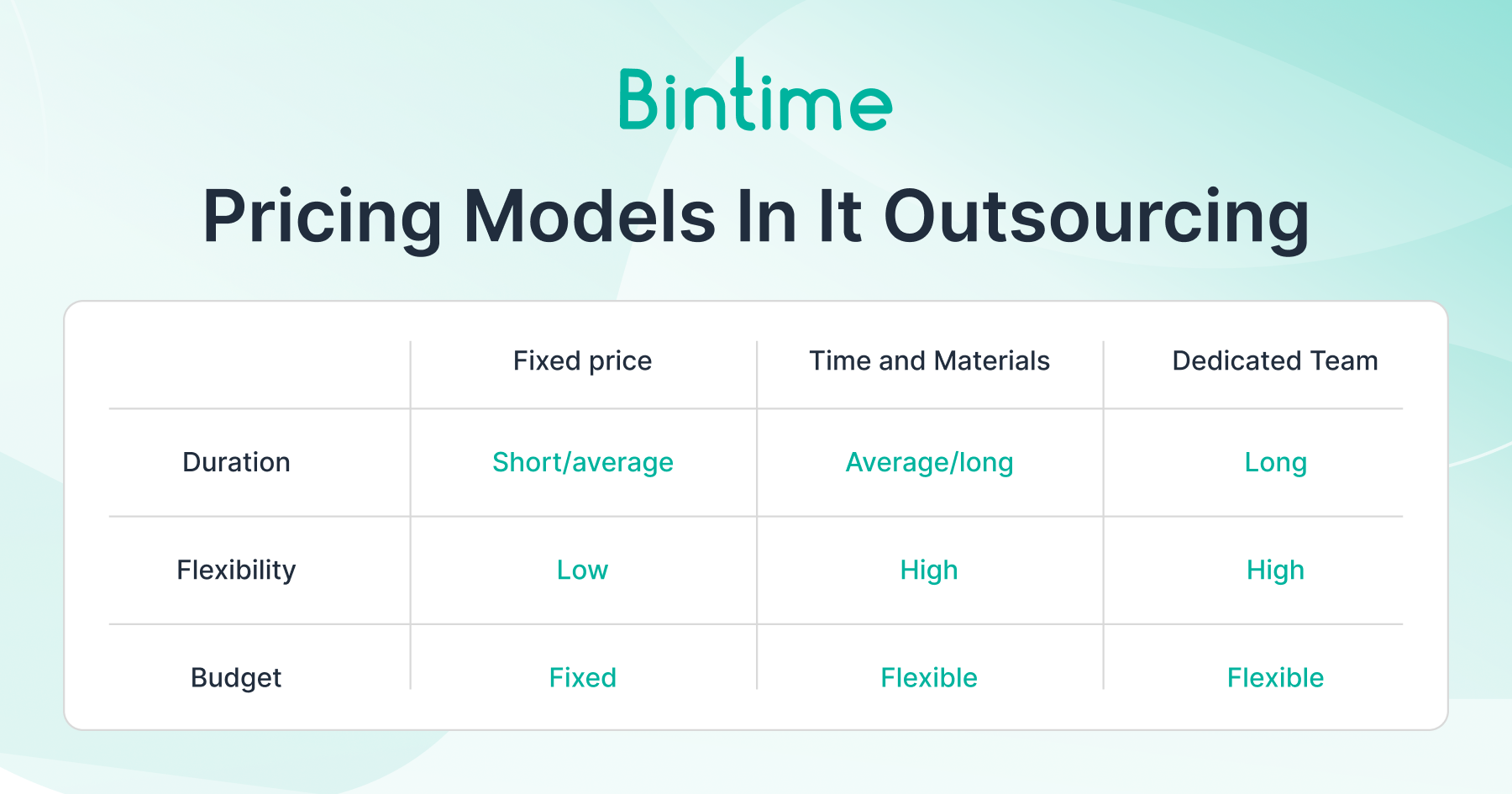
- Fixed price model. This one is adopted when the requirements and scope of the project are well-defined so the vendor can accurately estimate both the time needed for its completion and the budget to be allocated down to a penny. This scheme is often adopted by startups and small businesses on short commons that have a very particular project to be executed.
- Time and material model. It may happen that the customer doesn’t have the final vision of the product they want to obtain so its features and design are moot points to be discussed on the hoof. The T&M model is a perfect fit for such cases where the client pays for the number of hours and materials utilized in the development process. Typically, this model is onboarded by customers who want hands-on control of the project’s implementation.
- Dedicated team model. In this case, you don’t outsource the project but rather hire the IT personnel to be used at your discretion. You pay it on a monthly basis and apply its expertise wherever you need it.
Whatever model you will eventually select, it is mission-critical to avoid IT outsourcing pitfalls.
Addressing Challenges of Managing Outsourcing Partner
Having a long history of collaboration with many blue-chip brands, we know the pain points that can hamper cooperation between the customer and the IT outsourcing company.
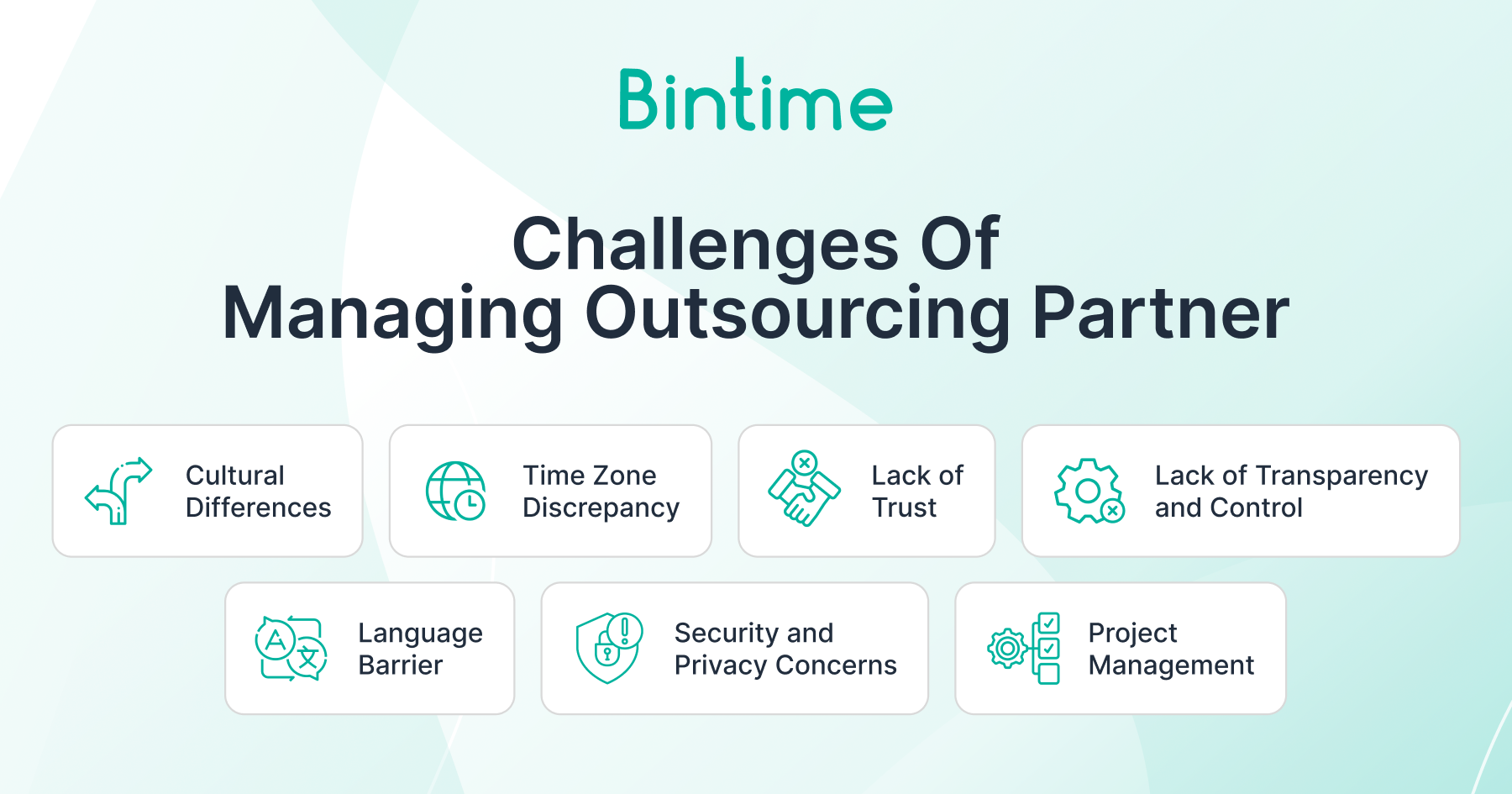
Challenge 1: Cultural Differences
If you outsource to some distant region, it is vital to come to grips with the values and cultural specifics of this country. Online research will be highly instrumental in it, and communicating with people who have experience in collaborating with the representatives of this culture is still better.
Challenge 2: Time Zone Discrepancy
Hiring a vendor from far away, you should also be aware of the difference in your time zones. To alleviate the problem, it is better to outsource to locations where such difference is minimal. For instance, for customers from Western Europe (say, the UK or the Netherlands) IT outsourcing to companies hailing from Eastern Europe (for instance, Ukraine or Poland) is preferable. The one- or two-hour difference between them will enable scheduling meetings and holding online communication that will be comfortable for both parties.
Challenge 3: Language Barrier
Of course, you can use translation software or hire an interpreter, but even if you do, the collaboration will be significantly hamstrung. That is why it is advisable to choose an IT outsourcing vendor whose personnel has a strong command of English. And in the contemporary globalized world, it is a must for developing companies with big-time aspirations.
Challenge 4: Lack of Transparency and Control
From the outset, you must make sure the vendor understands what you expect from them as well as realizes the specifics of the project and the industry it belongs to. Besides, you should keep in permanent touch with them to clarify issues promptly and nip problems in the bud.
Challenge 5: Lack of Trust
IT outsourcing vendor management is all about trust which is developed in the process of cooperation. To foster it, you should make certain you see eye to eye with your partner as to the principal milestones of the project and deliverables to be arrived at. Regular communication sessions are also a great help in building rapport between the parties and keeping both satisfied with the cooperation.
Challenge 6: Security and Privacy Concerns
Since you will share with the vendor various sensitive personal data and secret business information, you should check the compliance with security protocols and intellectual property rights (including patents and copyrights). Besides, your partner should implement maximum data protection measures to forestall leakages and penetration attempts.
Challenge 7: Project Management
Cooperating with remote teams is a tough row to hoe where outsourcing partner management is of primary significance. A competent project manager will keep all the development cogs well-greased and keep the cooperation machine running until the finished product is delivered.
Another important aspect of selecting an IT outsourcing partner is determining whether they will be up to the mark to handle the particular project.
How to choose an IT outsourcing country?
A company or entrepreneur looking to delegate certain IT operations or whole IT development projects has to make an essential strategic decision – which offshore country to outsource to?
There are several points to consider when picking the most fitting outsourcing destination, including outsourced developers’ rates, the size of the local IT market, as well as possible cultural and time-zone barriers.
1. Study Hourly Rates of Developers
Cutting costs is the major reason to outsource IT tasks for almost 60% of entrepreneurs out there. The second most common reason is acquiring talents that are scarcely found locally. Don’t over focus on savings, though, because there obviously can be no high quality without proper underlying investments.
You have a great chance to find the most favorable option, however, by studying average IT outsourcing rates in different regions and comparing them.
To make your life easier, there’s a cheat sheet with outsourcing prices across regions right above in the article.
2. Analyze the level of IT tech development across regions
Your main takeaways when understanding the level of local IT progress should include the number of tech educational establishments (universities, IT colleges, etc.) that graduate specialists you require (designers, developers, etc.), the range of available employees available on local job boards, and your project’s tech stack popularity among local specialized communities.
You are surely to get the most reliable and productive talent from the outsourcing destination that is well on the map of global IT, offers a wide range of available qualified specialists, and keeps the local education on a high level.
The only major common difficulty may arise when you need a narrow-profile professional specializing in a niche tech stack (e.g., Q#, Elang, Scala, etc.).
3. Consider the time zone
There is a common opinion that the 1-2 hour time-zone difference only boosts the efficiency of development, but we beg to differ. You are guaranteed to achieve much better results, streamline workflows, and cut time-to-market by adopting the “follow-the-sun” approach. The main gist here is to timely delegate tasks across departments so that everything keeps in motion around the clock.
This approach “squeezes out” the benefit of gradually distributed tasking out of working with remote, geographically dispersed specialists. Developers may complete designers’ tasks while the designers are asleep, and vice versa. And the main coordination for all involved employees is to simply follow the sun – work during normal day working hours and let other team members do the same.
Still, the 1-2 hour time-zone difference approach may fit you better in case regular live communication must be maintained during the project workflow. It allows making business gatherings without bothering anyone’s sleep.
4. See how you fit culturally
They say it is nearly impossible to really measure cultural compatibility. We disagree, it is pretty hard unless you put some effort into it.
Your fastest and easiest route to get guarantees of smooth collaboration culture-wise is through feedback from companies and entrepreneurs that have tried outsourcing to a certain location.
Just make sure to do your research – call up your potential outsourced vendor and clarify all the nuances, from the local legislative specifics and taxes to the common management approach.
Considering the aspect of cultural compatibility is crucial for achieving harmonious workflow vibes and setting off smooth, error-free workflows.
How to Evaluate Outsourcing Partner’s Proposal
There are several aspects of any IT outsourcing company’s workflow and functioning you should review to establish how adequate your choice of a vendor is.
- Gauge Industry Experience
While communicating with the partner’s management and staff, you should find out the number of projects they completed that belong to the same field as your future endeavor. Go into some details about these accomplishments to have an idea of the developers’ qualifications in the niche. - Assess Technical Expertise
The vendor should describe the tech stack they are going to employ for your project and explain the methodology to be used for managing projects, tracking progress and results, and combatting issues. - Ask for References and Samples
Alongside speaking with the company’s representatives, you should also check their site and peruse case studies presented there. To make doubly sure the information given there is accurate, contact previous customers and ask how satisfied they were with the cooperation with the IT outsourcing partner and its results. - Inquire about Communication
The company must offer a single point of contact and be flexible in the choice of communication channels both sides are comfortable with to provide a smooth exchange of information between you and them. - Have a Look at Infrastructure
An ideal IT vendor should utilize state-of-the-art hardware with the most recent software “living” in it as well as have a stable internet and telephone connection. - Fathom Financial Stability
Partnering with an IT outsourcer with doubtful solvency and questionable stability, you expose yourself to all kinds of risks (from financial to reputational). - Size up the Workforce
Looking at the IT outsourcing vendor’s hiring policies and processes, you can get an idea of the hard and soft skills the company considers essential for its employees and see how those match your vision and expectations. - Clarify Costs
Everything is fair and square if you have agreed upon the fixed price model. Otherwise, you should make clear all overhead expenditures and hidden costs that may crop up during the project.
These are bread-and-butter practices of evaluating an IT outsourcing company but approaching the choice of a partner requires following a strict sequence of moves.
The 6-Step IT Vendor Selection Process
With the wealth of offers in the current market of IT outsourcing services, the procedure of sieving through possible options should be especially stringent.
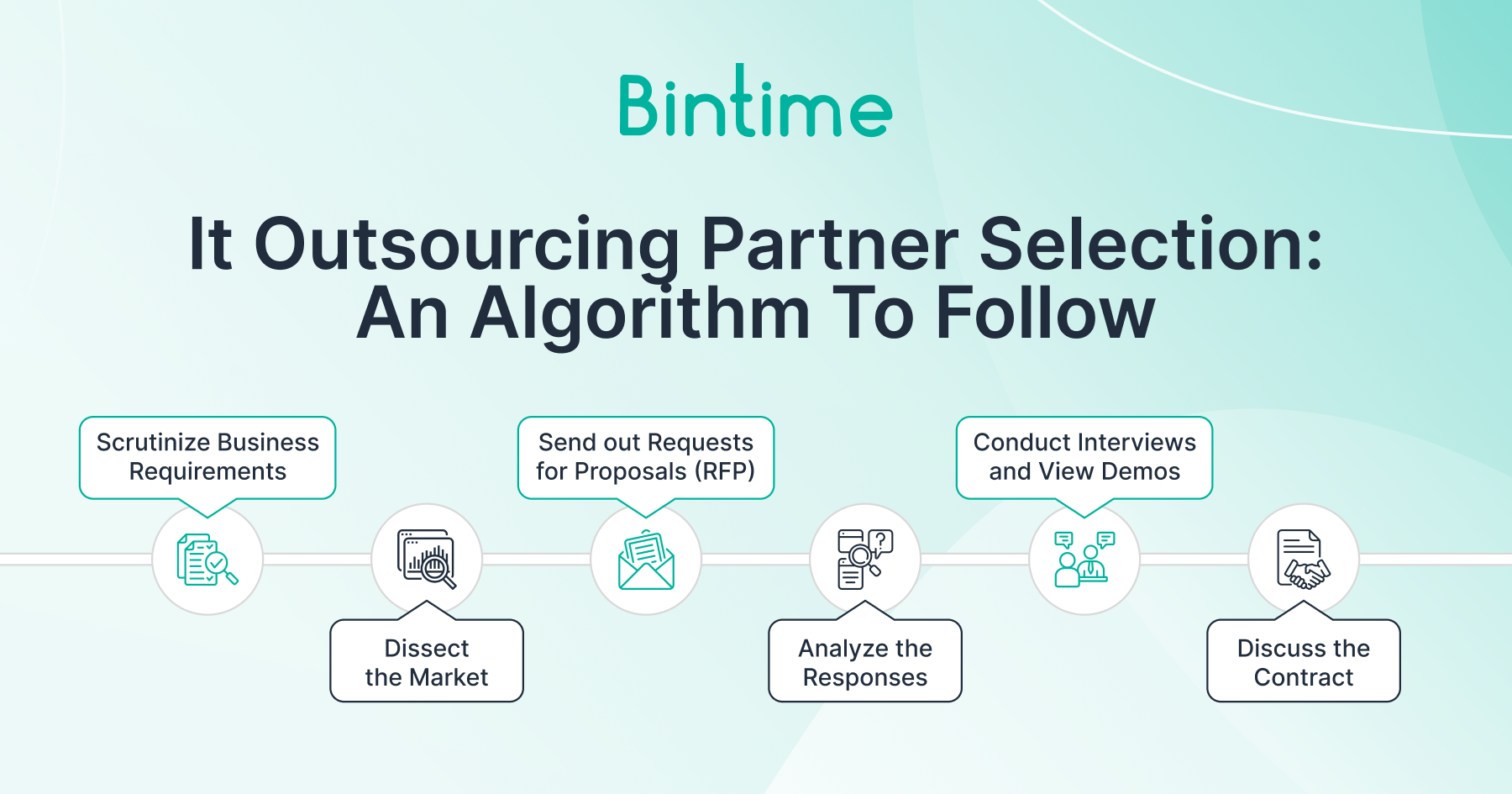
Step 1. Scrutinize Business Requirements
This is the preliminary phase that should be completed before you actually begin your search. You should define technical, functional, and business requirements for your future IT product so that the selection of a vendor should be made in accordance with them.
Step 2. Dissect the Market
Go through the reliable niche sites (like Clutch and GoodFirms) and mark top-ranked vendors with good reviews. Other sources of vendors to choose from are research papers and industry publications (Gartner and Forrester are among the most trustworthy ones).
Step 3. Send out Requests for Proposals (RFP)
Also known as Request for Quotation (RFQ), this document contains business goals and constraints, detailed specifications, terms and conditions, selection and submission details as well as your contact information.
Step 4. Analyze the Responses
Once the responses start coming in, you must compare them to identify the most attractive offers. To streamline the procedure, you should create a spreadsheet where you will enter the relevant information. The analysis should leave you with three or four potential partners to move on to the next stage.
Step 5. Conduct Interviews and View Demos
Each of the shortlisted IT outsourcing vendors is interviewed and samples of their solutions are analyzed to find the best fit among the options left.
Step 6. Discuss the Contract
Once you have made your final choice, it is time to negotiate terms, including budget, deadlines, specifications, and deliverables.
Here are some additional lifehacks that will make vendor selection in outsourcing easier and cooperation smooth:
- Feasibility studies and market research are necessary prerequisites for the data-driven choice of the IT outsourcing partner.
- Choose a provider from the same or similar time zone.
- Choose a provider who extends meeting compliance requirements and offers enhanced security of data and processes.
- Provider focused on iterative development is what you should look for.
- Define project goals clearly and make sure all stakeholders are on the same page in this respect.
- Progress updates should be regular and frequent with robust feedback from both parties.
Value-added with Bintime as an IT Outsourcing Partner
Outsourcing to a software development company, customers want more than just a high-end product at a moderate price. An ideal IT outsourcing partner is one that becomes a part of the client’s business family and aspires to elevate the brand in the long run. We at Bintime hold similar views on business cooperation and are ready to join efforts with you in your quest for achievement.
We are a Dutch company that excels in providing IT outsourcing services to many major-league players in the EMEA market, delivering robust, elegant, and supportable e-commerce and retail solutions. Our team of over 150 seasoned developers with 15+ years of experience created multiple software products for distributing and managing product content. Our special pride is the Gepard IT platform of our own making, honed to facilitate the running of B2B and B2C e-stores.
“Two decades after our founding, we are proud to have been recognized as IceCat, Top EU Content Provider Platform, Powerful PIM & Vendor Central. We always remain focused on talent recruitment and development, as well as creating a vibrant culture and community for all our teams: in-house (the main office is located in Amsterdam) and outsourced (located in Kyiv). IceCat began it’s outsourcing journey back in 2001. I needed help with some product information management, syndication, and infrastructures. Outsourcing developers have helped me with producing and distributing accurate and timely product information to tens of thousands of channel partners worldwide.” – Martijn J. Hoogeveen , CEO, Icecat NV
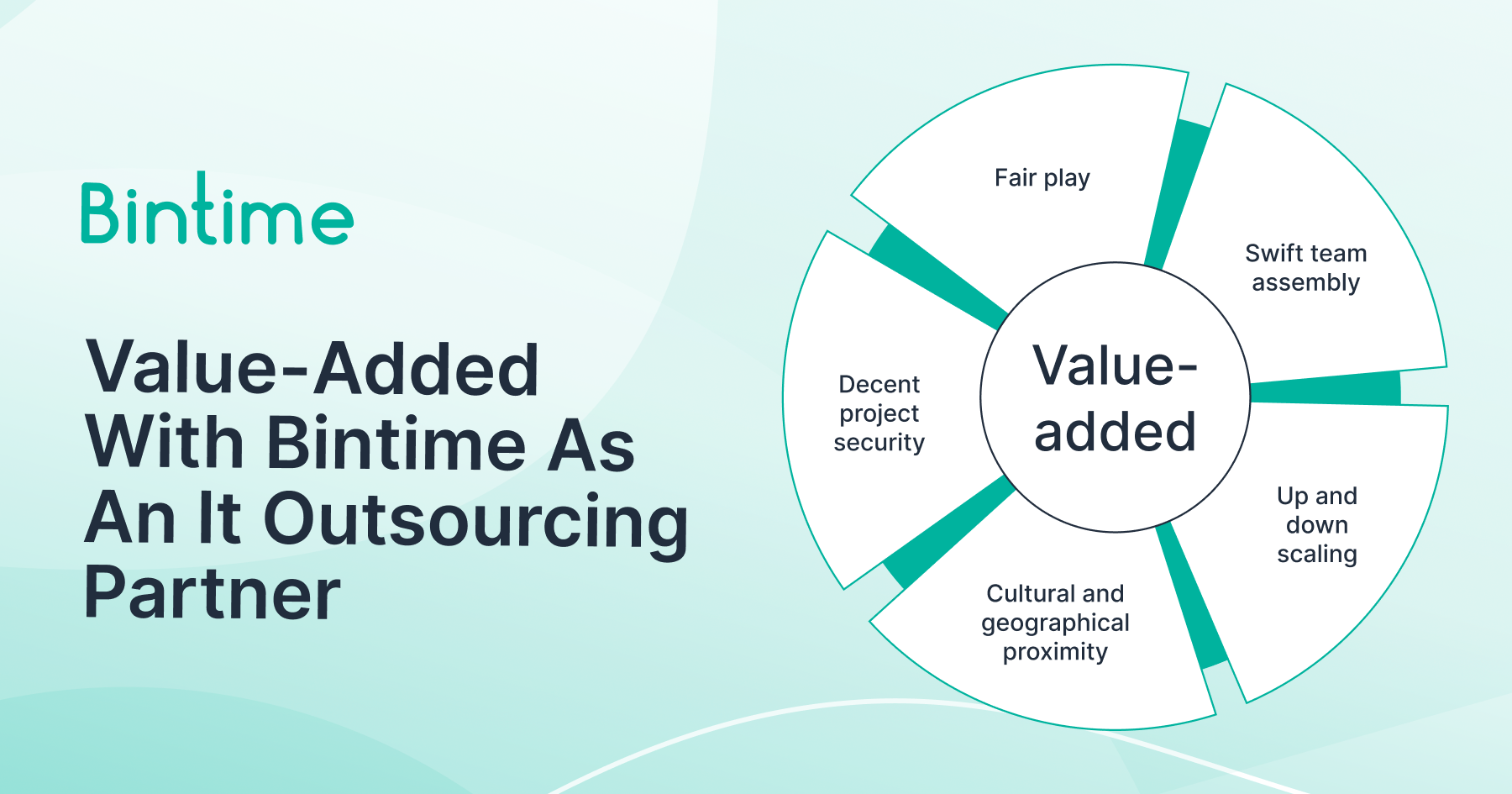
When Bintime IT company starts cooperating with your brand, we take a 360 view of your organization to envision what digital products can solve your business problems, maximize your revenues, and propel growth. Other value-added you get with us includes:
- Fair play. As our partners testify in their reviews, we promise only what we can deliver, and deliver it we do.
- Swift team assembly. It takes us no longer than 5 weeks to get a team of competent developers ready to tackle your project hammer and tongs.
- Up and down scaling. Whenever project or business needs require it, we will augment the crew or reduce its size to save you a pretty penny.
- Cultural and geographical proximity. Our strong work ethic and dedication to what we do, together with the utmost work hour synchronization flexibility and fluent English make us a delightful partner to cooperate with.
- Decent project security. We provide total compliance with data security regulations related to industry and customer data. Besides, we follow and monitor the execution of the NDA we sign.
Conclusion
IT outsourcing is a viable cooperation model that allows companies to receive high-quality digital products at a moderate price without keeping an IT department on their permanent payroll. It is extensively utilized not only by cash-strapped startups but by many business behemoths as well. If their example inspires you, contact us to obtain the IT solution of your dream.











